Resource information
It is well known that in many rural communities in the developing world, forests, particularly those under community management, are important for people’s livelihoods. However, studies on the contribution of forests to the income of different households within a community are rare, including the poorest households and how non-members of the community forestry user group (CFUG) benefit from those resources. This paper compares livelihood strategies and the use of a mangrove CF by different community members in Myanmar. Utilizing a livelihoods approach, data were collected through a household survey (n = 110) and various participatory tools. The significance of CF for people’s livelihoods was clearly demonstrated, with as many as 91% of households depending on CF products to varying degrees. Livelihood strategies are largely determined by financial assets and road access. Strategies include large levels of dependence on natural resources such as homegardens and CF. Substantial differences were found for CF’s contribution to total income depending on CF membership (p = 0.004) and wealth (p = 0.022). Non-members benefit mostly through subsistence products. The poorest households were found to get the highest income shares (36%) from CF. This leads to the conclusion that with an inclusive process to membership, CF has the potential to reduce poverty.


